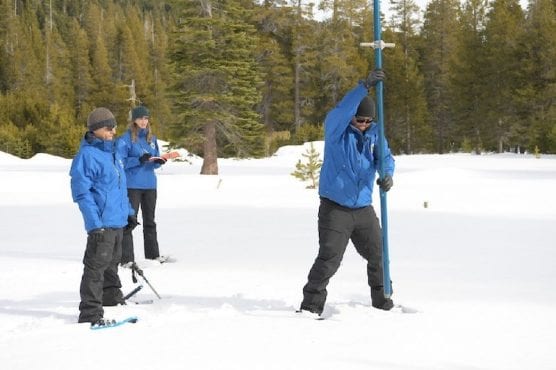By Matthew Renda
(CN) – The men in blue winter jackets and black snow pants trudged deliberately to the microphone to deliver the good news – the Sierra Nevada snowpack is in good shape as the calendar flips to 2020, which bodes well for California.
“December is the first of our big three, when we get half our annual precipitation,” said Michael Anderson, state climatologist with the California Department of Water Resources. “The first one has done well, but we still have two to go.”
Anderson and other members of California’s water department were on hand at Phillips Station, one of the snow courses were water managers take a snow survey to determine the size and quality of the snowpack in the Sierra Nevada mountains.
The survey is closely watched because snowpack provides nearly two-thirds of the state’s water to residents, businesses and farmers, particularly those in the southern end of the Central Valley who require water from the north to hydrate their parched land.
Thursday’s snowpack results were favorable: 33.5 inches, which is 97% of average for this date. While that number pertains to the Phillips Station – located near Echo Summit just a stone’s throw from the Lake Tahoe’s south shore – a network of sensors placed throughout the Sierra Nevada show snowpack at 90% of average.
In other words, the snowpack is right on track. The water content is also on target, which is comforting for water managers.
“The water content in the snowpack is the most important thing we are looking at,” said Shawn de Guzman, the water department’s chief of snow surveys. “It gives us a more accurate reading of how much water will filter out of the mountains during the spring and summer runoff.”
Water managers are particularly pleased with the latest readings given the uncharacteristically dry start to the water year, which begins on Oct. 1 in California. Only a few patches of precipitation fell on the state during October and November, extending the fire season and prompting rounds of blackouts from the Golden State’s largest utility provider in Pacific Gas & Electric.
But since the advent of December, storms have consistently marched through the state and dumped copious amounts of rain in the lowlands while building up the snowpack in the Sierra. A good December, though, is no indication of a robust water year, as Anderson noted.
“There is fantastic variability in California,” he said.
The spigot, once turned on, could easily dry up for the rest of the season, he cautioned.
The true indication of whether California had a quality year regarding precipitation is the snow survey performed on April 1, when the snowpack has historically been at its peak.
Due to warming temperatures, however, the historic peak is moving into March. Climate change also means water managers expect less precipitation to fall as snow in the mountains, meaning the snowpack is likely to decline as global surface temperatures continue to increase.
“As the world continues to warm, it’s important to conduct these measurements so we can track the changes,” Anderson said.
But for now, California – only a few years removed from a crippling five-year drought – is on track for a good water year. Only a sliver of the northern portion of the state is experiencing conditions the U.S. Drought Monitor categorizes as “abnormally dry.”
The outlook for the rest of the United States is fairly positive as well, despite a few dry spots.
The Pacific Northwest has seen a lower share of precipitation than normal, with the Willamette Valley in Oregon and western noncoastal parts of Washington state experiencing a moderate drought.
The only place experiencing extreme drought are a couple of patches in southern Texas.
The Four Corners region – the intersection of Colorado, Utah, Arizona and New Mexico – has been in drought for a few years and continues to experience drought-like conditions, albeit slightly moderated.
Like this:
Like Loading...
Related





 Tweet This
Tweet This Facebook
Facebook Digg This
Digg This Bookmark
Bookmark Stumble
Stumble RSS
RSS
























REAL NAMES ONLY: All posters must use their real individual or business name. This applies equally to Twitter account holders who use a nickname.
2 Comments
The “men” in blue is inaccurate as the picture accompanying the story clearly shows a “woman” in blue too.
Good thing the snowpack is in good shape since we may have to close many of our ground water wells due to PFAS contamination. We must have not gotten as much rain in the SCV as usual because the Santa Clara River has no surface flow in the upper reaches.